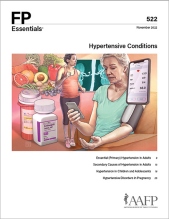
This clinical content conforms to AAFP criteria for CME.
Secondary hypertension (HTN) refers to high blood pressure (BP) caused by an identifiable and potentially correctable condition or disease. Common causes of secondary HTN include renovascular disease, renal parenchymal disease, primary hyperaldosteronism, drug and substance use, and obstructive sleep apnea; less common etiologies include pheochromocytoma/paraganglioma, Cushing syndrome, thyroid and parathyroid conditions, congenital adrenal hyperplasia, and aortic coarctation. An identifiable secondary cause of HTN is present in approximately 10% of adult patients with HTN. Early recognition of suggestive clinical findings and laboratory results enables the timely diagnosis of specific secondary causes of HTN. Correct diagnosis of a causative underlying condition can lead to more effective, even curative management and subsequent cardiovascular risk reduction. Management involves treating the underlying condition. Some patients may benefit from referral to a specialist with specific expertise in treating the causative condition.
Case 2. AJ is a 34-year-old patient, who comes to your office for further evaluation and management of high blood pressure (BP). His BP was 160/95 mm Hg during a workplace health screening. It has been similarly elevated with a home BP measurement and in the office today. He reports bilateral leg muscle cramps, worsening over the past month, as well as intermittent palpitations described as irregular heartbeats. His body mass index is 29 kg/m2. AJ’s father and his brother both had hypertension (HTN) diagnosed before age 35 years. An electrocardiogram (ECG) today shows atrial fibrillation, and laboratory test results show a low potassium level.
Subscribe
From $350- Immediate, unlimited access to FP Essentials content
- 60 CME credits/year
- AAFP app access
- Print delivery available
Edition Access
$44- Immediate, unlimited access to this edition's content
- 5 CME credits
- AAFP app access
- Print delivery available
